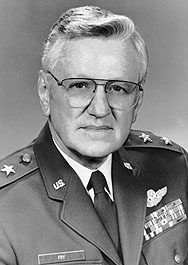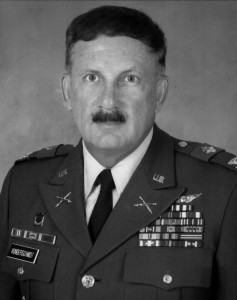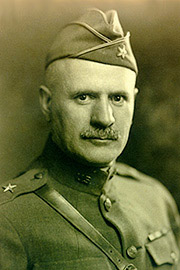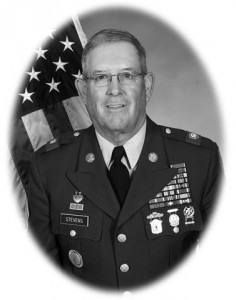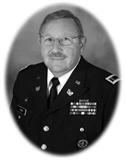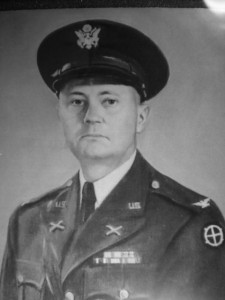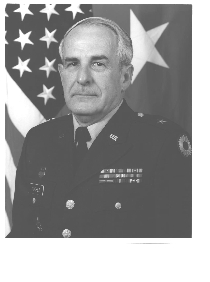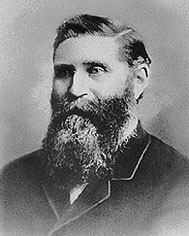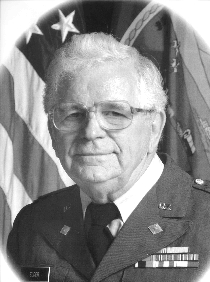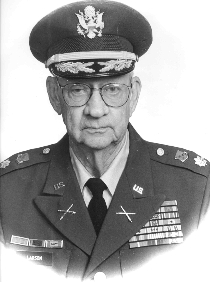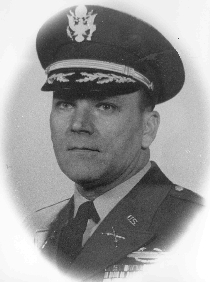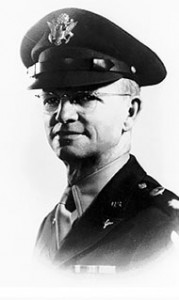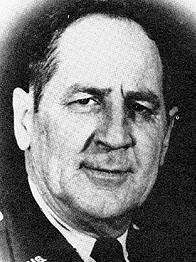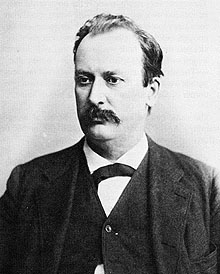This regiment was first organized in the month of July, 1861, by authority given by Brigadier General Lyon, whilst on the march toward Springfield. W. C. Ransom, and others from Fort Scott, visited General Lyon, and represented to him the exposed and unprotected condition of the southeast portion of the state of Kansas, and asked for authority to organize a force for home protection against threatened invasions from Missouri. The authority was at once granted W. C. Ransom to organize three companies of infantry which were to be stationed at Fort Scott and known as “Home Guards”. The three companies were speedily raised, and officered as follows, viz.; W. R. Judson, Major,; Company A, Captain W. C. Ransom; Company B, Captain W. T. Campbell; Company C, Captain Gower.
It was soon ascertained that these three companies were inadequate for the protection of the border, and by authority granted by Major Prince, commander of the post of Fort Leavenworth, August 12th, 1861, five new companies were organized, which were designated and officered as follows, viz.; Company D, Captain L. R. Jewell; Company E, Captain H. S. Greeno; Company F, Captain J. W. Orahood; Company G, Captain H. M. Dobyns; Company H, Captain A. W. J. Brown. Four of these companies, D, E, F, and G, were cavalry, and one company, H, was infantry. The entire five companies were mustered into the United States Service for three years.
The regiment having eight companies fully organized, measures were taken to form a regimental organization. Accordingly on the 9th day of September, an election for field officers was held, and resulted as follows, viz.; Major William R. Judson, Colonel; Captain Lewis R. Jewell, Lieutenant Colonel; Captain W. T. Campbell, Major; Charles O. Judson, Adjutant; George G. Clarke, Quartermaster; John S. Redfield, Surgeon.
Immediately after this organization was effected, the recruitment of a new company was commenced, which was subsequently completed and mustered into service as company H, Lieutenant David Mefford Captain.
In the meantime, Charles F. Clarke obtained authority to recruit a company in Riley county, Kansas, which he succeeded in doing in a remarkably short time. In the month of October, 1861, his company was mustered into service and designated company I, Charles F. Clarke, Captain.
The work accomplished by the battalion prior to its organization as a regiment, was no inconsiderable amount. The three infantry companies which were first organized were kept constantly on garrison duty at Fort Scott, until the 1st of September, when, after the battle of Drywood and the evacuation of the town of Fort Scott, they then marched, with other troops, under command of General Lane, to Fort Lincoln, where they remained on duty until General Lane started on the memorable march into Missouri, known as the “Osceola Expedition”, when the entire force of the Sixth was sent back, under command of Colonel Judson, to reoccupy and garrison Fort Scott.
The four cavalry companies, D, E, F, and G, were constantly employed scouting the country and watching the movements of the enemy.
Company E, under command of Captain Greeno, participated in the battle of Drywood, on the 1st of September, 1861. On account of Captain Greeno’s familiarity with the country, he was detailed, with his company, by order of Colonel Johnson, of the Fifth, to take the advance, and was the first to attack the enemy, which brought on a general engagement.
During the winter of 1861 and ’62, the regiment was stationed at Fort Scott. The four infantry companies performed garrison duty, and the four cavalry companies performed the scouting and picket duty. The scouting parties were almost daily engaged with the bushwhackers, or small detachments from the rebel army.
In the spring of 1862, in consequence of the imperfect, and irregular manner in which the Kansas troops were organized, this regiment was reorganized under the following order, to wit;
“Headquarters, Kansas Militia, Topeka, March 27, 1862,
General Orders No. 26.
. . . . . . . . . . . .
“VI. The Sixth Regiment (Cavalry) will be organized as follows; Colonel,——–; Lieutenant Colonel–L. R. Jewell; 1st Major–W. T. Campbell; 2d Major–W. C. Ransom; Surgeon–John S. Redfield; Asst. Surgeon–Joseph A. Smith; Adjutant–Isaac Stadden; Quartermaster–Charles H. Haynes. Company A, Captain George W. Veale. Company B, Captain E. E. Harvey. Company C, Captain H. S. Greeno. Company D, Captain John W. Orahood. Company E, Captain H. M. Dobyns. Company F, Captain C. F. Clarke. Company G, Lieut. J. M. Laing. Company H, Lieut. David Mefford. Company I, Captain Van Sickle. Company K, Lieut. John Rodgers.
. . . . . . . . .
“By order of the Governor and Commander-in-Chief,
(Signed), “CHARLES CHADWICK,
“Adjutant and Quartermaster General of Kansas.”
At the time of the reorganization, companies A, B, and C, which were first organized as Home Guard companies, were ordered to be mustered out of service. Immediately after the muster-out of these companies, the following changes were made to wit:
Company H, Captain Brown, was transferred to the Eighth Kansas Infantry; Captain G. W. Veale’s company of the Fourth Regiment was transferred to this regiment, and made company A; Captain Harvey’s company of the Fifth Regiment was transferred to the Sixth, as company B; company E, Captain Greeno, was changed to company C; company F, Captain Orahood, was made company D; company G, Captain H. M. Dobyns, was changed to company E; company I, Captain Clarke, was made company F. In the mean time a part of a company was recruited, and designated company G, Lieutenant Laing, subsequently Captain Lucas. Company H retained its original letter under Lieutenant Mefford. at the date of the consolidation, Captain Van Sickle’s “Independent company of Scouts” was assigned to this regiment, and called company I. This company was irregularly mustered into service, and really was not a part of the Sixth Kansas, and was subsequently mustered out as an irregular troop. Lieutenant John Rodger’s company was assigned to the Sixth Regiment, as company K.
Soon after the consolidation was made, one battalion, (companies C, H, and K), under command of Major Campbell, was detached and ordered to report to Colonel Clayton, of the Fifth Kansas, and marched with his command to Carthage, Mo,; the regiment remained at Fort Scott. In the month of May the battalion rejoined the regiment at Fort Scott, and with companies D, E, F and G, were ordered to Paola to be rearmed and equipped.
The regiment was divided and stationed along the line, Major Ransom, with two companies, at Little Santa Fe, Mo., Captain Orahood, with two companies, at Trading Post Kas. The balance of the regiment was stationed at different points along the southern line of the state, and changed from place to place as emergencies demanded, with headquarters at Paola.
The regiment was constantly engaged in disbanding small forces which were organizing in Missouri under Si. Gordon, Quantrell and Uphayes. Company A, under Captain Veale, made a very successful raid into the Sni Hills, Mo. On this occasion, Captain Veale and Lieutenant Johnson, with company A divided into two detachments, broke up eight camps of bushwhackers, killed thirty-seven of the enemy, and wounded about the same number. They also captured over fifty stand of small arms, and about sixty head of horses with equipments, and completely broke up the organization of rebel squadrons in that section of country until the return of the rebel General Jackman, and restored peace for a term of three months.
About the first of June, 1862, company I, Captain Van Sickle, was mustered out of service, which left the regiment with an organization of but nine companies.
In the month of June, the regiment concentrated at Fort Scott, and companies C, H, and K, under command of Captain Greeno, were detached and ordered to report to Col. Doubleday, Second Ohio Cavalry, to accompany his expedition south into the Indian country, and participate in the battle of Cowskin Prairie.
The command went into camp at Baxter Springs, Kas., where the Sixth regiment joined it on the 20th of June, excepting company B, which was left at Westport, Mo., under command of Major Ransom.
On the second day of July accompanied the expedition under command of Colonel Weer into the Cherokee country; and on the 4th of the same month succeeded in overtaking and engaged a rebel force under command of Colonel Clarkson, which resulted in his capture, together with the main portion of his command, and all his camp and garrison equipage. The Sixth was sent in pursuit of those that had escaped capture.
On the same day, a detachment of two companies of this regiment, under command of Captain Greeno, attacked a camp of rebels under command of Colonel Stan Waitie, at Stan Waitie’s Mills, and after a spirited engagement, succeeded in routing the enemy, and capturing a large quantity of sugar and other commissary stores, which were destroyed for want of transportation.
On the 5th of July, the entire command went into camp at Wolf Creek, where it remained until the 10th, when it moved south to Grand River, and encamped at Flat Rock Creek, eighteen miles from Fort Gibson.
In the meantime the Sixth regiment was detached, and order to proceed west until it struck the hills of the Verdigris, and from thence move south and form a flanking party to the main column. On this march, the regiment, whilst moving through the country, took possession of a large number of beef cattle, which were turned over, to order of the commanding officer at Flat Rock, to A. McDonald, beef contractor.
The regiment encamped with the rest of the forces and was kept constantly engaged in scouting the country south– some small parties went beyond the Arkansas river. On one occasion, a party of five men charged and drove in the rebel pickets in front of Fort Gibson.
Whilst the command was in camp at Flat Rock, about the middle of July, 1862, Colonel Weer, commanding the division, sent a detachment of sixty men of the Sixth Kansas, and one hundred Indians, under command of Captain Greeno, to Tallequah, the capitol of the Cherokee Nation, who succeeded in capturing John Ross, principal chief, Colonel William Ross, Major Pegg, and eight other officers of the rebel army. Two hundred Indians belonging to Colonel Drew’s regiment, deserted and joined the Federal command, and returned with it to camp.
About the same time, Major Campbell, with six companies of the Sixth Kansas, made a very successful reconnaissance to the Arkansas River, opposite Fort Gibson, and engaged the enemy across the river, and returned to camp without a loss.
Whilst Colonel Weer was actively engaged in preparing to make an attack upon the enemy at Fort Gibson–about 2,000 strong–a misunderstanding arose between him and Colonel Solomon, of the Ninth Wisconsin Infantry, who placed Colonel Weer in arrest, and assumed command of the expedition, and the contemplated attack was abandoned.
On account of the rebel Generals Jackman and Coffey concentrating their forces in Northern Arkansas, it was deemed advisable to leave the Indian country in possession of the loyal Indians, and return for the protection of the border from a threatened raid. Accordingly Colonel Solomon ordered a countermarch in the direction of Fort Scott.
A detachment of twenty-seven men of this regiment, under command of Lieutenant Johnson, with three Indian guides, were ordered to proceed to Northwest Arkansas, for the purpose of ascertaining, if possible, the movements of the enemy that threatened a raid upon the unprotected border of Kansas. The scouting party proceeded north, parallel with the western line of Arkansas, and thence, by a forced march during the night, succeeded in surprising a small party of rebels at Maysville, and captured some prisoners, from whom they ascertained that small squads had begun to move northward on various routes, and that their intention was to surprise Fort Scott if possible, and devastate the country by fire from thence along the border to Kansas City. But, should the eastern border of Kansas be protected, they would leave Fort Scott to their left, and pass on various routes through Missouri, and concentrate in Jackson county in that state, and thence make a raid south and sweep all the weak garrisons in western Missouri.
Upon Lieutenant Johnson receiving this information, he made a forced march, and intercepted the command at Cowskin Prairie, and immediately communicated the same to the commanding officer. The Sixth regiment was then ordered to take position on the extreme right of the column, and scout through western Missouri. The entire command, except the Indian regiment, returned from the expedition south about the first of August, and encamped on Drywood, east of Fort Scott, for the purpose of recuperation and rest. But , as usual, the Sixth was not allowed to remain idle. General Blunt immediately assumed command of all the forces, reorganized the brigades, and prepared for active service.
On the 13th of August orders were received to leave regimental headquarters at Fort Scott, and to leave all sick in post hospital, for the purpose of making a march in pursuit of a rebel force of about five thousand (5,000) under General Cooper, which had passed north about forty miles east of Fort Scott, towards the Missouri river. Colonel Cloud, with detachments of the Second and Sixth Kansas regiments, struck the enemy’s line of march in the rear, and immediately followed up in pursuit.
General Blunt, with the balance his command, “leaving a small force to garrison Fort Scott,” started in pursuit of the enemy, and followed him to Lone Jack, at which place he had been repulsed by Missouri troops, and had commenced to retreat southward. Colonel Cloud with the Sixth and Second Kansas, took the advance of General Blunt’s army, and on the 21st of August engaged the enemy’s rear at the crossing of the Osage river, driving him until nightfall. The men and horses being very tired from excessive fatigue, he rested for the night. On the 22d Colonel Cloud renewed the pursuit, but after a hard day’s march, found that the enemy had made good his escape.
On the following day, Colonel Cloud returned, with a part of his command, to Fort Scott, leaving about four hundred (400) men, under command of Lieutenant Colonel Bassett, to rest a day, with orders to return to Fort Scott on the 24th. On the morning of the 24th, Lieutenant Colonel Bassett started with the detachment of the Second Kansas, leaving the detachment of the Sixth, under command of Major Campbell, to follow in the rear. The advance had proceeded but a short distance, when a rebel force, of about one thousand two hundred, (1,200) under command of Shelby, was discovered moving south. Colonel Bassett at once united his forces and started in pursuit of the enemy, who, upon observing the movements of the Federal troops, turned aside, and took position on Coon Creek, to the right of the road. The position of the enemy was naturally strong. Adjoining the timber were two cornfields, with a lane running between them and the timber. The advanced guard, in attempting to force a passage through the lane, were encountered by heavy fire from the enemy, which resulted in a loss of three or four men wounded. Colonel Bassett then formed a line on the north side of the field on the prairie, and ordered Captain Greeno, with twenty-six (26) men, to deploy to the right as skirmishers, and pass through the cornfield, dismounted, and at the same time sent Lieutenant Gordon, with a detachment, to the left, for the purpose of ascertaining the strength of the enemy, and bring on a general engagement. As Lieutenant Gordon approached the timber, the enemy poured in a heavy fire upon his men, wounding the Lieutenant in the head, and several of his men, and compelled him to fall back. Captain Greeno, with his detachment, at once crossed the fence and entered the timber, and advanced a few rods, when about three hundred (300) of the enemy suddenly raised from a ravine, and sent a volley into the line of skirmishers and charged them. The men raised from the ground, where they had been lying down to escape the enemy’s fire and repulsed the charge with their revolvers. In the meantime Captain Greeno was wounded in the right hand and left arm. Two (2) of his men were killed and a number of them severely wounded. The Captain, finding that he could not contend against so large a force of the enemy, ordered his men to fall back.
Colonel Bassett, finding that the enemy outnumbered his force, and posted in a strong natural position, withdrew his troops, and marched in the direction of Fort Scott. The command camped for the night at Lamar, Missouri, and cared for the wounded. The following day, August 25th, 1862, the detachments of the Second and Sixth Kansas rejoined the main command at Fort Scott.
Soon after the return of the regiment to Fort Scott, it was on the move into Southwest Missouri, as a part of the Second Brigade, First Division, Army of the Frontier.
Upon concentration of the forces at Coxie’s Creek, in front of the enemy, the Second Brigade was ordered to take position on the left of the army. This position caused the cavalry to watch the movements of the enemy, who had communication with Northern Missouri, through the counties of Dade and Lawrence, and keep open communication with General Totten’s forces, which were camped between Mount Vernon and Springfield. The Sixth, being the only cavalry regiment in the brigade, and having such an extent of country to guard, it was kept constantly employed.
During the two weeks the Army of the Frontier lay in camp at Coxie’s Creek, this regiment performed some very valuable scouting service. On one occasion, a party of men, under command of Sergeant Henderson, of F company, made a scout up Cedar Creek, attacked and scattered a party of rebels, and succeeded in capturing a number of prisoners, from whom valuable information was obtained in regard to the strength and position of the enemy, also the route by which reinforcements passed south from Northern Missouri. The manner in which this scout was conducted reflected great credit upon the Sergeant in command, and showed at once that he merited promotion, which he soon received.
As soon as the information collected was communicated to Colonel Weer, command the brigade, Lieutenant Johnson was ordered to select fifty (50) men from the regiment, and proceed up Cedar Creek, under cover of darkness, and lay in ambush in front of Sarcoxieville, where a rebel brigade was encamped, and to intercept, if possible a scouting party of the enemy, which was making a reconnaissance in the rear of the Union forces. The Lieutenant, upon reaching the position, distributed his men, and placed them at the three fordings of the creek, in front of the enemy, where they remained within a half mile of the rebel pickets for twenty-four hours. About the dawn of day of the second morning, it was ascertained that the rebel scouting party was returning on the road leading to the center crossing, and being in such close proximity to their camp, were entirely off their guard. Upon crossing the creek, they at once ran into the ambuscade prepared for them, which resulted in a loss to them of five (5) killed, and ten (10) prisoners, besides a number wounded, who escaped on their horses. A detachment of five men were left in charge of the prisoners, with orders to proceed towards camp, whilst the balance of the party proceeded to drive the enemy’s pickets. Lieutenant Johnson returned to camp with his prisoners, without loss of a single man, either killed or wounded.
On the 24th of September, a detachment of the Sixth, in company with a detachment of the Third Wisconsin Cavalry, was ordered to proceed down Shoal Creek, and disable the water mills, from which the enemy drew his supplies. The object of this party was accomplished, after considerable skirmishing, and with considerable difficulty and hard marching, it returned with a loss of five (5) men.
On the evening of the 29th of September, 1862, a detachment under command of Captain Mefford was ordered to report to Lieutenant Colonel Jacobbi, Ninth Wisconsin Infantry, who was in command of a force composed of detachments of the different regiments, and charged with the duty of attacking the enemy, who occupied Newtonia, and ascertain his strength and position. The balance of the command was to follow the next morning.
Colonel Jacobbi moved to within four miles of the town and encamped for the night. At daylight the following morning he pushed his forces through a dense wood, and drove in the rebel pickets. But the enemy was prepared, and at once sent out a decoy, and succeeded in drawing the advance into an ambuscade, which would have resulted in a disastrous defeat, had it not been for the daring bravery of the men, and commendable gallantry of the officers. Captain Mefford rallied his men and held the enemy in check until the artillery could fall back. By this time the entire army was advancing to attack the enemy at Newtonia, the Sixth leading the advance. They had not proceeded far, however, when portions of the command sent out the day previous were met in full retreat. Upon ascertaining the perilous condition of Captain Mefford’s command, the regiment pressed forward to relieve them. Lieut. Colonel Jewell, with the three companies of the advance and two howitzers, under command of Lieutenant Benedict, moved forward and attacked the enemy on his right flank. The rebels fell back about two miles and formed in a field, with their left flank resting on a ravine, their right being supported by two pieces of artillery and infantry. Colonel Jewell, with three companies and howitzers, attacked the right, and at the same time Captain Veale charged the left flank. The enemy fired one volley with small arms, and fled in great confusion. The regiment pursued the retreating column to within gunshot of the town, when the enemy opened fire with artillery, and after making some demonstrations it was ascertained that his forces were en masse in the town. The howitzers being too light to reply to the enemy’s artillery, the regiment was ordered to retire about one mile, which it performed under a heavy fire. Several men in the meantime were wounded. About 2 o’clock Colonel Phillips arrived on the field with an Indian Brigade. The Sixth took position on the extreme right, where it remained the balance of the day, and about 7 o’clock was ordered to cover the retreat of the army.
The following is the official report;
“On the morning of the 30th, in pursuance of orders, I detailed three hundred men and officers from my regiment, and proceeded in the direction of Newtonia, and after having traveled about ten miles on that road, met a small party of Col. Lynde’s and Col. Solomon’s regiments, with two pieces of Captain Stockton’s battery and two howitzers, in full retreat before the enemy, who informed me that Colonel Lynde with a part of his regiment and Captain Mefford’s company of the Sixth, were surrounded by the enemy.
“I soon came to where appeared to have been a slight skirmish, counted some ten killed and wounded, who were completely stripped of their clothing, and left lying in the hot sun–the day was very hot and sultry. Took one prisoner. There we caught the first glimpse of the enemy, and followed him to the prairie, where he formed his line of battle, three miles out from Newtonia on the Sarcoxie road. I at once ordered my men into line and directed Lieutenant Benedict to bring his mountain howitzers into position on the gallop; then threw a few shells, and the enemy fell back. My men followed them with a great shout to the town, where the Lieutenant again commenced shelling them, when the enemy opened his battery upon us within short range, with three guns, using shell and round shot pretty freely. Here Lieutenant Phillips had his horse killed under him by a round shot. To get out of range–the howitzers being too light to reply successfully–I ordered my men to retire to a bluff, about one mile to the enemy’s front and immediately sent a courier back to General Solomon, informing him of the enemy’s position, and asking for reinforcements. This was about 10 o’clock a.m., and at about 2 o’clock p.m., Colonel Phillips arrived with his Indian regiment, much to our gratification, having held the enemy–seven thousand strong–in check for four hours, by continually skirmishing with them, notwithstanding the heavy cannonading we received from him. At about half-past three the balance of the command arrived.
“The portion of the enemy that I attacked were Texas regiments, well armed, that had been selected on purpose to follow our retreating force, and if possible capture our artillery, which was then in full retreat, as at that time there was but little support for it.
“My command, officers and men, behaved with great coolness and bravery. The only trouble I had was to keep them at what I considered a proper distance from the enemy.
W. R. JUDSON,
“Col. Com’dg Sixth Kansas Cavalry.”
On the 4th of October the regiment was again engaged at Newtonia, and occupied the right of the line of battle. After the enemy withdrew his forces and started on the retreat, the regiment joined in the pursuit of the flying rebels, and only abandoned the chase when men and horses were completely exhausted. Upon its return, it joined the main command and marched through Pineville, Mo., and encamped at Kent. After resting a few days it moved to a camp near Keetsville, Mo.
One of the most successful scouts made whilst in this camp was performed by Captain Gordon, company F, with a detachment of forty men. They made a raid on White River, and succeeded in surprising a detachment of the enemy who were guarding a mill. They killed ten men and captured twenty-five prisoners, together with all their horses and camp equipage and about forty stand of small arms, besides destroying a considerable quantity of flour and wheat. The Captain returned to camp with the prisoners without the loss of a single man killed and but three wounded.
On the 20th of October the regiment moved with the command to Bentonville, Ark., and the night following marched to the vicinity of Old Fort Wayne, N.C., preparatory to attacking a rebel force, about 3,000 strong, under General Cooper, at that place. On the morning of the 22nd the advance of the command surprised and drove in the rebel pickets. The Sixth was ordered to the front, and companies A and F, under command of Lieut. Col. Jewell, directed to take position on the right of the Second Kansas Cavalry. Colonel Jewell ordered his detachment to dislodge a squadron of rebel cavalry that occupied a point of timber on his right. This they succeeded in doing, and as soon as it was discovered that the enemy was giving back, Colonel Jewell ordered a charge, which completely uncovered his main line. Colonel Jewell, upon seeing this, immediately wheeled his small force to the left and gallantly charged the infantry which supported the enemy’ artillery. At the same time the center was charged by the Second Kansas Cavalry, and the entire line driven back in utter confusion. The enemy abandoned his battery and artillery horses. His battle-flag fell into the hands of the Sixth. No doubt this handful of cavalry would have been counter charged and the battery retaken, had it not been for the timely arrival of the Eleventh Infantry and Rabb’s Second Indiana Battery, which opened a well-directed fire on the enemy, who was rallying in the edge of the timber, within a few hundred yards of the battle field. The retreating column was followed up by the entire Sixth regiment and a part of the Indian brigade, which succeeded in capturing and destroying the enemy’s train. In this engagement the regiment had several men wounded, amongst the number, Private George Armstrong, company A, mortally wounded.
While the army lay in camp at Old Fort Wayne, the regiment was constantly employed in scouting the country, and was engaged almost daily with the foraging parties of the enemy. On one occasion, a rebel force under command of Colonel Emmett McDonald, was attacked and driven across the Boston Mountains,. The command, after lying in camp at Old Fort Wayne about two weeks, moved to Flint Creek, and established a camp known as Camp Babcock, near the line of Arkansas, where it remained awaiting the arrival of commissary stores from Fort Scott, subsisting in the meantime upon beef and wheat; little flour and corn meal could be had in the surrounding country.
A very successful scout was made from Camp Babcock eastward to the tributaries of White River. A number of small parties of rebels were dispersed, a small train captured, and a considerable quantity of stores destroyed. The party returned to camp with a loss of but two men killed, bringing with it fifty Unionist from the hills of the White River, who had been hid away to avoid the conscription.
Soon after the return of this scouting party, Lieutenant Colonel Jewell was ordered to take command of the entire effective force of the Sixth, including the two howitzers, together with detachments from the Indian brigade, and proceed southward and ascertain the position of the enemy, who was reported to be encamped at Cane Hill. Upon Colonel Jewell’s arrival at that place, he ascertained that the rebel forces had retreated across the Boston Mountains, and were stationed along the Cove Creek Valley. Colonel Jewell took a circuitous route and fell in the enemy’s rear, and surprised a detachment of his forces at Dripping Springs, and returned through the Evansville Pass just in time to escape being cut off by a large cavalry force, under command of rebel General Marmaduke.
As Colonel Jewell passed through the mountains, the inhabitants greeted the Stars And Stripes with cheers, which clearly demonstrated the sentiments of the people of Northwestern Arkansas who had been forced to accept secession. The regiment upon its return to camp, rested there a few days with the command. On the night of the 26th of November supplies arrived, and preparations were at once made for a movement south.
On the morning of the 27th, the entire Army of the Frontier marched, without transportation, in the direction of Cane Hill, about forty miles distant, where a large cavalry force, under command of General Marmaduke, had concentrated. On the morning of the 28th, the cavalry and artillery was ordered to the advance at a trot, the infantry following as rapidly as possible, and about 9 o’clock made an attack upon the enemy, and after a very spirited engagement of two hours, succeeded in routing him. He was closely pursued to a spur of the Boston Mountains, where his command rallied and made a desperate effort to repulse the advancing column. The regimental howitzers poured in a heavy fire with canister from one side, whilst the Second Kansas and its howitzers poured in an effective fire on the other side, and Hopkins’ battery fired from the main front. He was soon driven from his strong position across the mountain. General Blunt then ordered a charge, which caused the enemy to fall back rapidly for some distance. The Sixth followed up and charged a force of the enemy that had formed in a strong position, and met the regiment with a dreadful fire. In this charge Lieut. Col. Jewell was mortally wounded; Lieut. Johnson, company A, was severely wounded through the left lung; Lieut. Hains, company K, was wounded in the neck; seven enlisted men were killed, and about twenty wounded. Lieut. Campbell was taken prisoner by the enemy. General Blunt by this time was pressing forward with a section of artillery and infantry to renew the attach, when a flag of truce was seen approaching from the enemy. “It now being nearly sundown,” the flag was met by General Blunt, and an armistice agreed to for one hour. Darkness coming on, the command fell back a few miles and bivouacked for the night.
The following morning, finding no enemy to fight, the command fell back to Cane Hill and encamped. General Solomon’s division, of which the sixth formed a part, was sent to Rhea’s Mills, about ten miles north of Cane Hill. Here the regiment remained until the battle of Prairie Grove was brought on.
At midnight General Solomon received orders to send the Sixth to join General Blunt’s command at Cane Hill, and at 2 o’clock on the morning of the 7th of December, the regiment broke camp and immediately started towards Cane Hill, where it arrived in sight of the town about daylight. Colonel Judson was met at the outskirts of the town with orders to move east with the Sixth regiment to the Fayetville and Cove Creek road, and ascertain if the enemy was moving northward on that road. Upon Colonel Judson’s reaching the point designated, he at once ascertained that General Hindman had passed up the road during the night with his main army.
Colonel Judson immediately sent messengers to General Blunt, informing him that the enemy had completely flanked him, and was marching towards Rhea’s Mills for the purpose of capturing the trains encamped at that place. Colonel Judson followed the enemy until he came up with his rear guard, and opened fire upon him with the two regimental howitzers. General Hindman at once halted his entire command and formed line of battle to the rear. This delayed the enemy several hours, and prevented him from reaching the train at Rhea’s Mills until General Herron with his command arrived from Springfield, and attacked the enemy in front, which brought on a general engagement.
General Blunt, upon receiving Colonel Judson’s dispatch, moved his troops with all possible haste toward Rhea’s Mills, and arrived on the battle field of Prairie Grove just in time to save General Herron from being defeated.
Colonel Judson finding that the main command had passed up the Cane Hill road, withdrew his small force, and rejoined General Blunt on the battle field about 3 o’clock p.m.
The enemy being stationed in the timber, the cavalry could not operate to advantage. The regiment, therefore, was held in reserve, and was not engaged during the evening.
There is no doubt that the valuable information furnished by Colonel Judson, and the detention caused the enemy by the attack made in his rear, saved the train from capture. Had the enemy not been detained, he might have met General Herron’s force, defeated it, and then turned upon General Blunt’s command, and thus defeated both divisions by detail. Whilst Col. Judson did nothing more than his duty, had he also failed, defeat, disaster and destruction must have been the result.
The battle was continued with great fury until nightfall, when the firing ceased, and the army fell back a short distance and bivouacked. During the night extensive preparations were made for renewing the conflict on the morrow. The trains were sent to the rear to Fayetteville, a full supply of ammunition distributed, and all the available troops at once ordered to the front.
About daylight the next morning, General Hindman sent a message under flag of truce, asking for a personal interview with General Blunt. Shortly after daylight an interview was held, which prevented the attack which was to have been made at dawn of day. It was found that the interview was asked for the sole purpose of gaining time, the rebels having muffled their artillery wheels and evacuated their position during the night. This dishonorable and unwarrantable act the illustrious rebel General Hindman was compelled to resort to in order to save his demoralized hosts from either being captured or annihilated on the retreat.
The day after the battle the regiment returned to its old camp at Rhea’s Mills, where it remained until the 27th of December, 1862, when it accompanied General Blunt’s expedition south to Van Buren, on the Arkansas river. Seven miles from Van Buren, at Dripping Springs, the regiment, in company with the Second Kansas, attacked and routed a force of Texas troops and succeeded in capturing their camp equipage and train. The Sixth and Second, leading the advance, dashed into the town of Van Buren, and with the assistance of some cavalry of General Herron’s command, captured four steamboats loaded with commissary stores and corn, besides taking possession of a vast quantity of stores of all kinds in the town.
At the same time, a detachment of the regiment under command of Captain Mefford, accompanied Colonel Phillip’s Indian brigade into the Indian country. On this expedition Colonel Phillips succeeded in capturing Fort Gibson and Fort Davis, destroying the latter place.
The expedition to Van Buren closed the campaign for the Winter. General Schofield arrived from St. Louis and assumed command of the Army of the Frontier, and ordered it back into Missouri.
At this time the regiment had but nine companies. In pursuance of General Orders from the War Department, the following order was issued for the purpose of making the organization a complete cavalry regiment, viz.;
“Headquarters Army of the Frontier,
“Rhea’s Mills, Ark., Dec. 31, 1862.
[Special Orders, No. 16.]
(Extract.)
“The following named officers, non-commissioned officers and privates of the First Division, Army of the Frontier, are hereby detailed on recruiting service and will report without delay to the commanding officer at Fort Leavenworth, Superintendent of Recruiting for the State; Captain H. S. Greeno, Sixth Kansas Vols.; Sgt. Maj. H. P. Ledger, Sixth Kansas Vols.; Private William Coates, Sixth Kansas Vols.; Private Martin O. Blood, Sixth Kansas Vols.
“By order of Brigadier General Blunt,
T. MOONLIGHT,
“Lieut. Col. and Chief of Staff.”
In pursuance of the above order, the detachment proceeded to Leavenworth and received the following order, viz.;
“Headquarters Supt’s Office Recruiting Service,
“Fort Leavenworth, Kas., Jan. 13, 1863.
[Special Orders No. 2.]
“Captain H. S. Greeno, Sixth Kansas Volunteers, with a party consisting of Sergeant Major H. P. Ledger, Private Wm. Coates, and Private M. O. Blood, Sixth Kansas Volunteers, having reported to these headquarters for the general recruiting service in the State of Kansas, pursuant to Special Orders No. 16, dated Headquarters Army of the Frontier, Rhea’s Mills, Ark., Dec. 13, 1862 will proceed to the city of Fort Scott, Kans., and there establish a recruiting rendezvous.
“By order of Lieutenant Colonel Burris,
J.M. HADLEY,
“Lieutenant Eighth Kansas Vols., Post Adjutant.
Captain Greeno and his party at once repaired to Fort Scott, and commenced recruiting operations. Soon after his arrival at that place, he received the following communication from the Colonel of his regiment, viz.;
“Camp on Cane Creek, 30 miles south of Springfield, Mo.,
“February 13, 1863.
“Captain Greeno; Dear Sir–I send a communication to the Governor for power to raise three squadrons to fill up my regiment. If it is granted, I authorize you to superintend the recruiting of these squadrons. I send Lieutenant Lane to see Captain Robinson, to prevail on him to raise one squadron. I send Mr. Bisbee, who will proceed to Kansas City to see Captain Johnson, and get him to assist in raising a squadron in that vicinity. And I further suggest that you put forward the Sergeant Major, now with you, to assist in raising the other squadron.
“Now, Captain, a united effort is necessary to raise these three squadrons, and I expect you to see that it is done. Do not leave a stone unturned to accomplish it at once.
“Truly your Friend, W. R. JUDSON,
“Col. Sixth Kansas Vol. Cav.”
In order that there should be no misunderstanding between the military and the executive, Captain Greeno visited the Governor at Topeka, and obtained permission to recruit the three squadrons necessary to fill the regiment to the required standard. The following is a copy of the letter from the Governor of Kansas;
“State of Kansas, Executive Office,
“Topeka, Feb. 23, 1863.
“Col. W. R. Judson, Sixth Regiment Kansas Volunteers;
“Sir–You are hereby authorized to cause the regiment commanded by you to be recruited to the standard required by General Orders of the War Department; Provided, that you use no special efforts to obtain recruits from the agricultural classes of this state. I am aware that the heavy drain upon Kansas has seriously crippled her farming interests, and I fear will be productive of serious consequences. While therefore I must guard this great interest against further oppressions, I will cheerfully officer such companies as can be raised without detriment to the state or any of its vital interests.
“Very respectfully, THOS. CARNEY, Governor.”
One company was recruited at Fort Scott in a very short time, and mustered into service as company L, with H. P. Ledger, Captain; J. Denton, First Lieutenant, and L. J. Swingley, Second Lieutenant. Company I was recruited soon after, at Westport, Mo., by Major Ransom and J. T. Blake, and mustered into service with J. T. Blake, Captain; S. D. Harris, First Lieutenant, and Levi Stewart, Second Lieutenant. In the meantime, Captain Greeno had succeeded in recruiting the third company at Fort Scott, but owing to some misunderstanding arising between the Governor and General Blunt, at that time, the company was mustered into service as company B, Fourteenth Kansas Cavalry. Company M was then recruited, composed principally of half-breed Delaware Indians, and was mustered into service July 30, 1863, with J. W. Duff, Captain; J. Brooks, First Lieutenant, and J. C. Anderson, Second Lieutenant.
The first battalion of the regiment was attached to the brigade commanded by Colonel Judson, and during the months of January, February, and March, 1863, it remained in camp on Crane Creek, near Springfield, Mo., when it marched for Fort Scott, Kansas. Soon after the arrival of the battalion at the latter place, the men received furloughs for a brief period.
On the 7th of May two companies marched from Westport to Salem, Missouri, as escort to the First Kansas Battery, and from thence marched to Rolla, Missouri.
On the 21st of June it was ordered to join General Blunt’s command, at Fort Scott, Kansas, where it arrived on the 1st of July. On the 4th of the same month the battalion was ordered, on a forced march, without tents, to proceed to Fort Gibson, C. N. July 17th the enemy was engaged at Honey Springs. The following is the official report of the part taken by the Sixth Regiment;
“Headquarters Sixth Kansas Cavalry, Volunteers,
“Camp near Fort Gibson, C.N., July 19th, 1863.
“Colonel W. R. Judson, commanding troops in the field, etc.;
“Colonel–I have the honor to report the part taken by my command, consisting of companies A, C, F and H, commanded respectively by First Lieutenant T. J. Darling, Second Lieutenant R. L. Phillips, Captain William Gordon, and Captain David Mefford; also section of mountain howitzers, under the command of Lieutenant J. P. Grassberger.
“My command left camp at four o’clock a. m. on the 16th inst., crossing the Verfigris river and Arkansas river in the face of the enemy, our crossing being covered by a section of Smith’s Second Kansas Battery. The crossing was effected without loss, the enemy retiring on our approach without firing a shot. After a halt of a short time, I was ordered with my command to the advance, detailing Captain Gordon with his company F, as the extreme advance. About daylight he came up with the enemy in considerable force, posted on a rise of ground near timber. The Captain immediately formed his men and opened a brisk fire in the enemy, but was compelled to fall back. I at once brought the rest of the command up at a gallop to the support of the advance, and after a sharp skirmish drove the enemy from his position, with a loss to him of one (1) killed and three (3) wounded, who were left on the ground. Privates Banks of company C, and Allingham, of company F, of my command, were wounded; also had one horse killed and several wounded. I immediately followed, coming up with him again at Elk Creek. Here I came to a halt, sending a company to reconnoiter; found the enemy strongly posted in the timber, with artillery, their line extending to the right and left of the road. I immediately dismounted a portion of my command, and moved up cautiously, opening fire upon them. They, however, kept under cover. Private White, company A, was at this time severely wounded. On the arrival of the main force, I was transferred from Colonel Judson’s command to that of Colonel Phillips’ (Colonel Judson retaining the section of howitzers) and ordered to the left of our battle line. Shortly after the engagement commenced, I discovered the enemy endeavoring to flank us under cover of timber. I immediately dismounted companies C, F and H, and sent them into the timber. They engaged the enemy immediately, and after sharp work of about an hour and a half succeeded in driving the enemy back, with considerable loss. About this time the First Indiana regiment charged the enemy on the left, relieving my men. I at once recalled my men from the timber, and after obtaining a supply of ammunition, mounted and started in pursuit. After crossing the creek, I charged into a large body of rebels, whom I supposed to be Stanwaite’s Indians and a regiment of Texans. They fell back to the woods and made a stand. My men dismounted, and opened a vigorous fire on them, which, together with the effective fire of the howitzers, soon drove them in confusion. I followed them until ordered to cease pursuit.
“The conduct of the officers and men under my command was excellent, they being cool and self-possessed during the entire engagement, particularly the detachment on duty with the howitzers; they advanced almost as fast as the cavalry, unlimbering their guns, and delivering their fire with remarkable celerity and correctness.
“My loss was light, considering the heavy fire under which we were, and consists of those whose names appear in the report,
“I have the honor to be, your obedient servant,
“WM. T. CAMPBELL
“Commanding Sixth Kansas Cavalry.”
After the engagement above mentioned, the regiment returned to Fort Gibson, C.N., where it was joined by the second battalion of the regiment.
On the 22d day of August it received marching orders, and proceeded, with the troops under command of General Blunt, against the rebel General Cooper. Lieutenant Phillips, command company C, had the advance with his company, and was constantly skirmishing with the enemy.
The command was then divided, and the Sixth regiment returned to Fort Gibson, where it went into camp on the west side of the Arkansas river. Whilst the regiment was in camp here, Captain J. T. Blake arrived with a new company. The regiment then moved, with the First Brigade, under command of Colonel Ritchie, to Northfork-Town, but was soon compelled to fall back to the Arkansas river.
On the 13th of November,1863, the regiment marched for Fort Smith, Arkansas, where it arrived on the 18th of the same month.
During the winter of 1863-4, it was employed in scouting, and escorting supply trains, and moved to Roseville. On the 26th of March the regiment joined the First Division, Army of the Frontier, then en route to join General Steele’s command.
The following is the official report of the part taken by the Sixth on the “Camden Expedition”;
“Colonel W. F. Cloud, commanding Third Brigade, Frontier Division, Seventh Army Corps;
“Sir–The Sixth Kansas Cavalry, Volunteers, consisting of regimental headquarters, and companies A, C, G, K and M, marched from camp near Roseville, Arkansas, under command of Lieutenant Colonel William T. Campbell, forming a junction on the 28th with the Frontier Division, commanded by Brigadier General J. M. Thayer. The regiment was then attached to the Third, or Cavalry Brigade, and on the 9th of April, on the Little Missouri river, formed a junction with the Seventh Army Corps, Major General F. Steele, commanding.
“The regiment participated in the skirmish on the 10th, 11th, and 12th, at Prairie de Ann; on the 13th, while preparing to march, was again attacked, the Frontier Division being in the rear. The enemy was repulsed, and driven from the field of action. On the 14th, company C lost nine (9) men, killed, wounded or captured, while foraging. On the 16th the regiment, with the main command, arrived at Camden, Arkansas. On the 17th the train left Camden for the purpose of procuring forage for the command, a portion of the detail for escort being made from the Sixth Kansas Cavalry, consisting of seventy-five (75) cavalry and the section of howitzers attached to the regiment, under command of Lieutenant Robert Henderson, company G. On the 18th the train was attacked and captured by the enemy, at Poison Springs, twelve miles west of Camden. In the engagement Lieutenant Robert Henderson was wounded and captured. Private C. C. Goodman, company D, attached to the howitzers, was killed. Private H. Gable, company K, was captured and several wounded. The detachments returned to Camden, and remained there until the 26th, when the regiment, with the command, took up its line of march for Little Rock. On the morning of the 29th, about 10 o’clock, while the command was crossing the Ouchita river, the enemy attacked our rear guard, which consisted of companies C and K, Sixth regiment. A sharp skirmish ensued, in which Private E. Grey, company C, was severely wounded, and two (2) men of company K missing.
“On the morning of the 30th the enemy attacked our army in force, while crossing the Saline river. In this engagement the regiment did not participate, two companies being occupied in guarding the fordings on the Saline river, the other companies with the Cavalry Division en route to Little Rock, where they arrived May 1st, `1864. At the crossing of the Saline river the medicine stores, tents and wagons, were burned, by order of Major General Steele, and unfortunately, the regimental records were all destroyed.
“On the 6th of May the regiment left Little Rock, and arrived at Dardanelle on the 9th. Same day had a skirmish with a party of rebels, in which Sergeant G. P. Freeman, company A, was mortally wounded, and Sergeant Joseph Powell, severely wounded. From Dardanelle the regiment marched for Fort Smith, Arkansas, where it arrived on the 16th of May.
“W. T. CAMPBELL,
Lieutenant Colonel Commanding Sixth Kansas Cavalry.”
During the Camden Expedition, Colonel W. R. Judson, of the Sixth Kansas Cavalry, commanded the District of the Frontier, to which he was assigned by order of Brigadier General Thayer. His command consisted in part of the Sixth Regiment, which operated in the vicinity of Fort Smith, and along the line of the Arkansas river, scouting the country from Fort Gibson, C. N., to Dardanella, Arkansas. The portion of the regiment remaining under command of Colonel Judson during this time, suffered severely in numerous skirmishes with the enemy. Company D, Captain Goss commanding, stationed at Roseville, was attacked by a large rebel force, but after a gallant resistance the enemy was compelled to retire with considerable loss. Captain Goss lost five (5) men killed, and several wounded, including himself in the latter number.
On the 5th of April a scouting party of the regiment, whilst escorting Assistant Surgeon S. A. Fairchilds to Roseville, was fired upon from an ambush, and thirteen (13) of the party of twenty-one (21) were killed, including Surgeon Fairchilds. The bodies of the victims were stripped of their clothing, and then mutilated in a most horrible and inhuman manner.
After the return of that portion of the regiment which participated in the Camden Expedition, the entire regiment, except company F, which was detached as personal escort to General Thayer, was engaged in scouting the country south and west of Fort Smith. The enemy having followed the retreating column from Camden, was constantly attacking outposts and foraging parties.
On the 26th of June, Sergeants S. McKibben, company L, was killed, while gallantly pursuing bushwhackers south of Fort Smith. At this time a battalion of the regiment was encamped on Muzzard Prairie, about six miles south of Fort Smith, under command of Major Mefford.
On the morning of the 27th of July, about six and a half o’clock, the battalion was surprised and attacked by a rebel force of about two thousand (2,000) men, and after a gallant resistance, Major Mefford, Lieutenant De Friese, and one hundred and fourteen (114) men, were taken prisoners.
The following is a partial report of the engagement at Muzzard Prairie, Arkansas;
“Fort Smith, Ark., July 29, 1864.
“Colonel W. R. Judson, Commanding First Brigade;
“Sir–I have the honor to report to you that I was in command of company B, Sixth Kansas Cavalry on the morning of the 27th inst., when the enemy made the attack on our camp, on Muzzard Prairie, and as soon as the alarm was given that the enemy was in the prairie, which was about six o’clock, a.m., I sent immediately for the herd which had been out grazing since daylight, and was about three-fourths of a mile southwest of camp. I formed my men on the right of the camp, to protect my herd as it came in, and until it could be secured, but before the horses could be brought up, the enemy charged on us, which stampeded the herd, and left the men on foot to fight as best they could. We drove the enemy back, and as I had received no orders from the commanding officer, I ordered my men to fall back until they could form on the right of the other companies. When I had fallen back to the left of my company’s parade ground, I came in speaking distance of Major Mefford, when I received orders to form my company on the right, to protect the camp. I immediately took the position assigned me, with company D on my left. We held our position, repulsing three distinct charges of the enemy. At this time I was that Major Mefford had, with companies E and H, been driven from their position on the left of the line, and had began to fall back across the prairie. I knew that I could not hold my ground much longer, with what men I had; so, without receiving orders from Major Mefford, commenced falling back toward him. As we fell back I had several men captured by the enemy that was advancing through the timber in the center of our camp. We fought and retreated in good order, until we came within half a mile of the house on the prairie, when the enemy closed in on all sides, taking many more of our men prisoners. Those that were left, continued fighting and falling back to the house. There the men that were left were overpowered and captured. Before we reached the house I received a slight wound in the right thigh. Some of my men who were first captured made their escape by hiding in the thick brush, the enemy not staying to hunt for stragglers, but left immediately after the men at the house were captured, taking with them all the men that could travel. All did well under the circumstances–it being a surprise after driving in the pickets, the enemy was in our camp. I lost in the engagement three (3)killed, two (2) mortally wounded, five (5) severely wounded, and forty (40) men taken prisoners.
JACOB MOREHEAD
“First Lieut. Sixth Kansas Cavalry, Volunteers,
“Commanding company B.”
REPORT OF KILLED AND WOUNDED ON JULY 27TH, 1864, AT MUZZARD PRAIRIE, ARKANSAS.
Jacob Morehead, First Lieutenant company B, severely wounded.
Thos. McCauley, Corporal, company B, killed.
Antoine Furtmire, private, company B, slightly wounded.
Marion Hinton, private, company B, severely wounded.
Edwin Jackson, private, company B, severely wounded
David P. McDonald, private company B, slightly wounded.
John G. Parker, private, company B, killed.
Edwin Parker, private, company B, slightly wounded.
George W. Rinker, private, company B, mortally wounded.
Joshua B. Zents, private, company B, killed.
Chas. S. Atkins, Sergeant, company D, severely wounded.
John Phillips, Sergeant, company D, slightly wounded.
Peter Bartness, private, company D, slightly wounded.
Albert H. Richie, private, company E, killed.
Thos. B. Landers, Corporal, company E, killed.
Joel G. Hutchin, private, company E, killed.
David Van Wormer, private, company E, killed.
James Weldon, private, company E, killed.
Thos. R. Griffin, private, company H, mortally wounded.
Daniel Jennings, private, company H, killed.
James S. Mounce, private, company H, slightly wounded.
George L. Harris, private, company I, killed.
Marshall Rice, private, company L, killed.
Lewis Pawnee, private, company L, slightly wounded.
William Patterson, wagon master, slightly wounded.
Captured: David Mefford, Captain, company H; J. M. DeFriese, Second Lieutenant, company E; forty enlisted men, company B; fifteen enlisted men, company D; thirty-four enlisted men, company E; twenty-one enlisted men, company H; six enlisted men, company L.
In the meantime, a large detachment of the regiment was trains between Fort Smith,
Arkansas, and Fort Scott, Kansas.
On the 21st of June, Captain John Rogers, company K, was killed in a skirmish with bushwhackers, near Fort Scott.
The regiment was engaged in performing picket and scouting duty, and almost daily encountered small parties of the enemy.
September 14th, companies L and M, and detachments from other companies, formed a part of an escort to supply trains from Fort Scott to Fort Smith, which was attacked by General Gano’s command.
The following is an extract from Captain Ledger’s statement in regard to the Cabin Creek engagement:
“The regiment marched from Fort Scott, Kansas, September 14th, 1864, arriving at Cabin Creek, C. N., September 19th, where it was attacked by the enemy about three thousand strong, with six pieces of artillery, under command of General Gano, and after a severe struggle, were driven from the field, and were compelled to take to the brush and retreat towards the Osage Mission, where they arrived on the 22d, nearly starved to death, having traveled seventy-five miles. All the effects of company L were lost, including the records that had been obtained since the engagement at Muzzard Prairie. Captain Duff’s company (M) also lost its property entire. The detachment of the regiment lost several killed, wounded and prisoners.”
On the 5th of October, 1864, all the men of the regiment whose term of service would expire prior to October 31st, 1864, by order of Brigadier General Thayer, were sent, under command of Lieutenant Campbell, to Fort Leavenworth, Kansas, to be mustered out of service.
On 23d of October, while the detachments were en route to Leavenworth, they were attacked at Cow Creek, Missouri, and a skirmish ensued, in which Captain Dobyns, company E, privates Lewis A. McGuire, company A, and Maxwell P. Johnson, company C, were killed, and a number of men were captured.
Captain Dobyns was a brave and good officer, of unexceptionable moral character; kind and generous, loved and respected by all his company, and by all who knew him. He had served his country faithfully for over three years, and was returning to Kansas to be mustered out, and to the enjoyment of the blessings of that Government he had fought so faithfully to transmit to future generations.
The following organizations were mustered out of service about the first of December, 1964, at Fort Leavenworth, by Lieutenant J. R. Kemble and Major W. O. Gould, mustering officers, viz.: Companies A, B, C, D, E, F, and K.
A detachment of the regiment at Fort Scott, under command of Lieutenant Clark, rendered signal service during the Price raid.
On the 29th of December, the portion of the regiment that was yet in service marched from Fort Smith for Clarksville, Arkansas, where it remained until the 16th of February, 1865, when it received orders to proceed to Little Rock, Arkansas. The fragments of the regiment were then consolidated, pursuant to the following orders, viz.;
“Headquarters Department of Arkansas, Little Rock, Ark., April 8, 1865.
[Special Orders No. 86]
(Extract.)
“V. Paragraph 9, Special Orders No. 70, Current Series, from these Headquarters, is hereby amended as to read: ‘the original service term of companies A, B, C, D, E, F, H and K, Sixth Kansas Cavalry, Volunteers, having expired, the re-enlisted men and recruits of same will, under supervision of the Commissary of Musters, for the Department, be so disposed of, that after assigning detachment company D, thirty-two (32) men, to company I, detachment company K, thirty-eight (38) men, to company L, and detachment company B, forty-eight (48) men, to company M, one new company, having an enlisted total of one hundred and six (106) enlisted men may be formed.
“The new company to be designated A, will be regarded as part of Sixth Kansas Cavalry, with officers as follows viz.:
“Charles O. Judson, Captain original Company F, to be Captain.
“Thomas G. Howell, First Lieutenant original company A, to be First Lieutenant
“William H. Shattuck, Second Lieutenant original company D, to be Second Lieutenant.
“Detachment company E, and detachment company H, will be considered as temporally attached to company G, until that company musters for discharge, when new company B will be organized and officered in orders from these Headquarters.
“By command of Major Generals J. J. Reynolds. JOHN SEVERING,
“Assistant Adjutant General.”
There-enlisted men and recruits of the several companies were disposed of as exhibited by the following letter, viz.:
“Office Commissary of Musters,
“Headquarters Superintendent Vol. Rec’t’g Service,
“Chief Mustering and Disbursing Office,
“Little Rock, Ark., April 8, 1865.
“To the Officer Commanding Sixth Kansas Cavalry, Volunteers:
“Pursuant to paragraph 5, S. O. 86, Current Series, from Headquarters Department of Arkansas, the re-enlisted men and recruits of companies A, B, C, D, E, F, H and K, Sixth Kansas Cavalry regiment, are hereby disposed of as follows, viz.:
“New company A–Charles O. Judson, Captain original company F, Captain.
“Thomas G. Howell, First Lieutenant original company A, First Lieutenant.
“William H. Shattuck, Second Lieutenant original company D, Second Lieutenant.
“Twenty-three (23) veteran volunteers, and nineteen (19) recruits original company A, privates.
“Twenty-four (24) veteran volunteers, and eighteen (18) recruits original company C, privates.
“Twelve (12) veteran volunteers original company F, privates.
“Ten (10) recruits original company F, privates; making one hundred and six (106) enlisted total for new company, with five (5) prisoners of war, now entitled to discharge, not included.
“Seven (7) veteran volunteers, and twenty-five (25) recruits, company D detachment, have been assigned to original company I.
“Three (3) veteran volunteers, and thirty-five (35) recruits, company K detachment, have been assigned to original company L.
“Twenty-three (23) veteran volunteers, and eighteen (18) recruits, company B detachment, have been assigned to original company M.
“Two (2) veteran volunteers, and eleven (11) recruits, company E detachment, together with fourteen (14) other recruits, company H detachment, have been temporarily assigned to original company G, with which they will serve until that company musters for discharge, then be embodied in new company B.
“All non-commissioned officers have been assigned as private soldiers, their offices having ceased to exist same date their original companies mustered for discharge, from which time they should only be allowed pay as private soldiers.
“For the new company A, the proper number of non-commissioned officers will be appointed with rank and pay from April 1st, 1865, when reorganization of company dates.
“Prisoners of war ‘entitled to discharge’ will be considered as temporally attached to that company in which their own proper detachments are embodied, and if non-commissioned officers, will retain rank and be entitled to pay as non-commissioned officers of original companies, until exchanged and returned to place where enrolled, or rejoin command for muster out.
“On muster pay rolls they will be taken up next after ‘discharge’, under heading, ‘prisoners of war entitled to discharge’, and be thus accounted for until they can be properly dropped.
“In all cases where men ‘absent sick’ are entitled to discharge the officer in charge of the hospital to which they were sent should immediately be notified, and request discharge to be granted, as contemplated by Sec. 4, Art. III, War Department Circular 36 of 1864, and until evidence of their discharge shall have been received, they will be carried at foot of muster pay roll, with necessary remarks explaining their status.
“When the command next musters for pay, all men borne on ‘Transfer Roll’ as ‘absent without leave’, will be dropped as ‘deserters’, with notes as to when and where they quit camp, and letter of company to which they then belonged.
“Herewith, for your information and guidance, ‘Transfer Rolls’, with notes over signature of the undersigned, showing company to which the several detachments have been assigned.
Very respectfully,
“Your obedient servant,
“A. O. VINCENT,
“Major and Commissary of Musters,
“Department of Kansas.”
In the meantime, company G was mustered out of service, but no new company formed, as contemplated in the foregoing instructions from the Commissary of Musters.
About the 5th of June the battalion was ordered to proceed to Du Vall’s Bluff, Arkansas, where it was joined by the prisoners of war on the 14th of the same month, who were upon their arrival, mustered out of service.
The battalion remained at the cavalry depot until the 18th of July, 1865, when it was mustered out of service by Lieutenant W. F. Morse, Third Minnesota Infantry, and placed en route to state rendezvous.
The battalion left Du Vall’s Bluff, Arkansas, July 27th, 1865, and arrived at Leavenworth, Kansas, August 11th, 1865, and remained there until the 21st of the same month, when it received final payment and discharge.
On account of the records of the regiment being destroyed, at two different times during its term of service, it is impossible to ascertain the distance marched, and many other interesting items, which should appear in the history to make it complete.
Although but few reports of engagements appear in the history, it will be seen by reference to tabular statements, contained in volume one, of Adjutant General’s Report, that Kansas lost a greater number of men killed in action an died of wounds, in proportion to the number of troops furnished, than any other loyal State, the per cent. being over sixty-one per thousand, whilst, the Sixth lost a greater number than any other cavalry regiment of Kansas troops, its loss being nearly eighty per thousand of the whole number enlisted.
(SOURCE: Report of the Adjutant General of the State of Kansas, 1861-’65. Topeka, Kansas: 1896 reprint. Transcription provided by Dale Vaughn, Civil War Round Table of Eastern Kansas.)

 Maj Gen David Weishaar
Maj Gen David Weishaar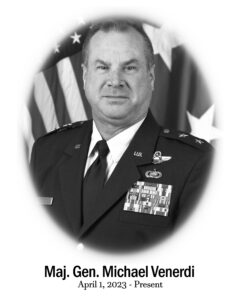


 First Sergeant Darrel W. Haeffele was born on September 25, 1940, in Falls City, Nebraska. He graduated from Atchison High School in 1958. He attended Concordia College in Seward, NE for two years before starting a career in retail.
First Sergeant Darrel W. Haeffele was born on September 25, 1940, in Falls City, Nebraska. He graduated from Atchison High School in 1958. He attended Concordia College in Seward, NE for two years before starting a career in retail. CW5 Roland E. “Ron” Kassebaum was born on February 21, 1946 in Deshler, Nebraska. He graduated from Hebron High School, Hebron, Nebraska in 1964. He attended Fairbury Junior College, Fairbury, Nebraska and the University of Nebraska, Lincoln, Nebraska, and received a Bachelor of Science Degree from the University of the State of New York in 1991. He later attended Liberty University, Lynchberg, Virginia, for courses in accounting and Allen County Community College, Iola, Kansas, for a course in Business Law.
CW5 Roland E. “Ron” Kassebaum was born on February 21, 1946 in Deshler, Nebraska. He graduated from Hebron High School, Hebron, Nebraska in 1964. He attended Fairbury Junior College, Fairbury, Nebraska and the University of Nebraska, Lincoln, Nebraska, and received a Bachelor of Science Degree from the University of the State of New York in 1991. He later attended Liberty University, Lynchberg, Virginia, for courses in accounting and Allen County Community College, Iola, Kansas, for a course in Business Law. Chief Warrant Officer Four Ronald E. Mullinax was born on August 25, 1946, in Norton, Kansas to Earl and Mary Posson. He was adopted by John and Ada Mullinax. He grew up in Lenora, Kansas, graduating from Lenora Rural High School in 1965. After completing a Denver Automotive Institute training program, Ron worked at Look Body Shop in Norton until 1968.
Chief Warrant Officer Four Ronald E. Mullinax was born on August 25, 1946, in Norton, Kansas to Earl and Mary Posson. He was adopted by John and Ada Mullinax. He grew up in Lenora, Kansas, graduating from Lenora Rural High School in 1965. After completing a Denver Automotive Institute training program, Ron worked at Look Body Shop in Norton until 1968. CCMSgt Valerie D. Benton was born on Dec. 10, 1959 in Racine, Wisconsin, where she spent her childhood. She graduated from Washington Park High School in 1978. Soon after graduation she enlisted in the U. S. Air Force and headed to Basic Training at Lackland AFB, Texas in December of 1978. After completion of Basic training, she attended Technical Training at Lowry AFB, Colorado, and graduated as a Food Service Specialist.
CCMSgt Valerie D. Benton was born on Dec. 10, 1959 in Racine, Wisconsin, where she spent her childhood. She graduated from Washington Park High School in 1978. Soon after graduation she enlisted in the U. S. Air Force and headed to Basic Training at Lackland AFB, Texas in December of 1978. After completion of Basic training, she attended Technical Training at Lowry AFB, Colorado, and graduated as a Food Service Specialist.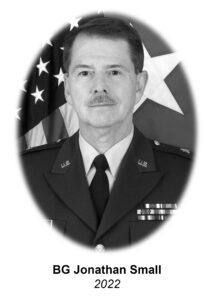 Brigadier General Jonathan P. Small served as The Adjutant General of Kansas from November 1, 2003 to January 4, 2004, culminating a 35-year military career as a distinguished attorney, community leader, citizen-soldier, and military leader. He served as Assistant Adjutant General-Army from 1999 to 2003, and as Commander of the Land Component for the Joint Force Headquarters-Kansas.
Brigadier General Jonathan P. Small served as The Adjutant General of Kansas from November 1, 2003 to January 4, 2004, culminating a 35-year military career as a distinguished attorney, community leader, citizen-soldier, and military leader. He served as Assistant Adjutant General-Army from 1999 to 2003, and as Commander of the Land Component for the Joint Force Headquarters-Kansas. General James H. Lane was a militia leader during the Bleeding Kansas period, the commander of the Kansas “Jayhawker” Brigade during the Civil War, and was one of the first United States Senators from Kansas.
General James H. Lane was a militia leader during the Bleeding Kansas period, the commander of the Kansas “Jayhawker” Brigade during the Civil War, and was one of the first United States Senators from Kansas. Sergeant Major Joseph T. “Jody” Muller was selected for the Kansas National Guard Hall of Fame for his exceptional service as a citizen soldier in the Kansas National Guard for over 41 years.
Sergeant Major Joseph T. “Jody” Muller was selected for the Kansas National Guard Hall of Fame for his exceptional service as a citizen soldier in the Kansas National Guard for over 41 years. Master Sergeant Greg Gilroy was born on July 25, 1947 at Ottawa, Kansas. He was a lifelong resident of Ottawa, graduating from Ottawa High School in 1965. He then attended Emporia State University during the 1965-66 school year.
Master Sergeant Greg Gilroy was born on July 25, 1947 at Ottawa, Kansas. He was a lifelong resident of Ottawa, graduating from Ottawa High School in 1965. He then attended Emporia State University during the 1965-66 school year.








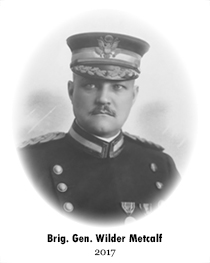

 Brigadier General Deborah Rose entered military service with a direct commission into the United States Air Force Nurse Corps in March 1983, assigned to the 184th Tactical Fighter Group. She transferred to the 190th Clinic in December 1985. In October 1990, she deployed to Jeddah, Saudi Arabia, where she served in an Air Transportable Hospital during Desert Shield. In February 1991, she was activated and deployed to Offutt AFB, Nebraska, assigned to the hospital.
Brigadier General Deborah Rose entered military service with a direct commission into the United States Air Force Nurse Corps in March 1983, assigned to the 184th Tactical Fighter Group. She transferred to the 190th Clinic in December 1985. In October 1990, she deployed to Jeddah, Saudi Arabia, where she served in an Air Transportable Hospital during Desert Shield. In February 1991, she was activated and deployed to Offutt AFB, Nebraska, assigned to the hospital.
 Sergeant Major Lynn E. Holt built his distinguished Kansas Army National Guard career developing strength, retaining Soldiers and insuring Soldiers received proper training. He served from the Detachment through State level. He is known for his ability to recognize Soldier needs at all levels. The same care he felt for Soldiers carried over into his community activities. SGM Holt’s passion for people and their needs exemplifies his true character. He devoted his entire adult life to the betterment of our nation, our state and the Kansas National Guard.
Sergeant Major Lynn E. Holt built his distinguished Kansas Army National Guard career developing strength, retaining Soldiers and insuring Soldiers received proper training. He served from the Detachment through State level. He is known for his ability to recognize Soldier needs at all levels. The same care he felt for Soldiers carried over into his community activities. SGM Holt’s passion for people and their needs exemplifies his true character. He devoted his entire adult life to the betterment of our nation, our state and the Kansas National Guard.



